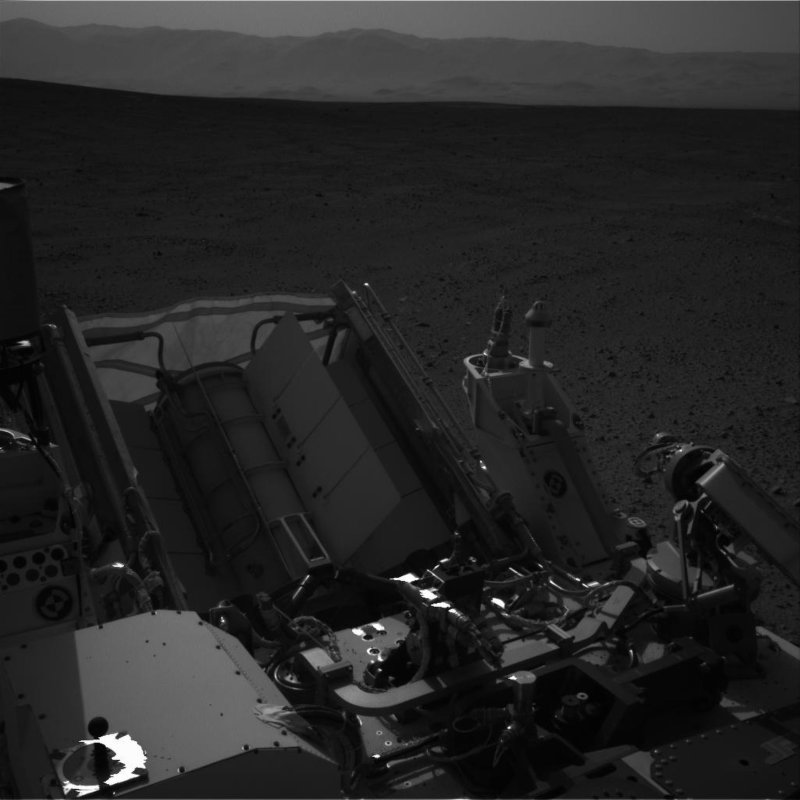1 of 6 | This image was taken by Navcam Left A onboard NASA's Mars rover Curiosity on September 16, 2012. Curiosity landed on Mars the evening of Aug. 5 PDT (morning of Aug. 6 EDT). UPI/NASA/JPL-Caltech |
License Photo
When a NASA official said last week data from an instrument on the Mars Curiosity rover suggested something "for the history books," many people thought an announcement was imminent of the possible discovery of life on the Red Planet -- until the space agency began to seriously backpedal on the story.
It may be a case of once bitten twice shy as NASA has been through this before -- a hotly anticipated and heavily hyped bit of news that only disappoints in the end.
The current excitement began when Curiosity mission lead scientist John Grotzninger started receiving data on his computer from the rover's on-board chemistry lab while in the presence of a reporter from National Public Radio.
The instrument known as Sam, sample analysis at Mars, has been analyzing a Martian soil sample.
"This data is going to be one for the history books. It's looking really good," Grotzinger told NPR.
Grotzinger would not reveal anything more, saying it could be several more weeks while NASA scientists went over the data to make sure it wasn't a glitch or something from earth contaminating the instrument sample.
Still, a lot of people thought "one for the history books" could only mean SAM had found something suggesting evidence of life on Mars at some point.
SAM is in fact designed to look for organic molecules and while organic molecules would be important, it is not the same thing as "life on Mars." NASA quickly began downplaying talk of a major discovery.
"It won't be earthshaking but it will be interesting," said spokesperson Guy Webster of NASA's Jet Propulsion Laboratory in Pasadena, Calif.
NASA's caution is understandable; it has been through this before.
In 2010 researchers led by then NASA astrobiologist Felisa Wolfe-Simon said they had discovered a form of "alien life" right here on Earth, bacteria found in a California lake whose DNA they claimed contained arsenic -- highly poisonous -- rather than phosphorus.
Announced with much publicity and fanfare at a NASA news conference, the finding intrigued astrobiologists, who'd previously speculated extraterrestrial life might survive in unexpected and extreme environments if it were based on something other than phosphorus or carbon -- something like arsenic.
But the finding was controversial, and soon other researchers said they were unable to duplicate the results Wolfe-Simon said she had discovered at California's Mono Lake.
Many scientists responded by saying the data made no sense, were inconsistent with well-established chemical principles and did not support the interpretation and conclusions in the study published in Science.
There was general disagreement with the original authors' contention that arsenic was incorporated into the DNA. The bacteria were highly resistant to arsenate, other researchers said, but they were still a phosphorus-based and thus a terrestrial life form.
The studies left astrobiologists disappointed and left NASA with a bit of egg on its face for having made initial "alien life" comments in its run-up to the very public introduction of Wolfe-Simon's original research. A suggestion by one of the coauthors of the Science article of a "shadow bioshpere" based on chemistry other than that found in life on earth has failed to gain any traction with biologists.
The "arsenic" episode is likely one reason NASA has in speculation about the Mars Curiosity discovery, to avoid a repeat of the embarrassment.
NASA now says it will be repeating tests to conclusively confirm its still-secret findings -- whatever they are -- and will not officially release them until December, at the next meeting of the American Geophysical Union, set for Dec. 3-7 in San Francisco.
Not "earthshaking," NASA reminds us -- just "interesting."















